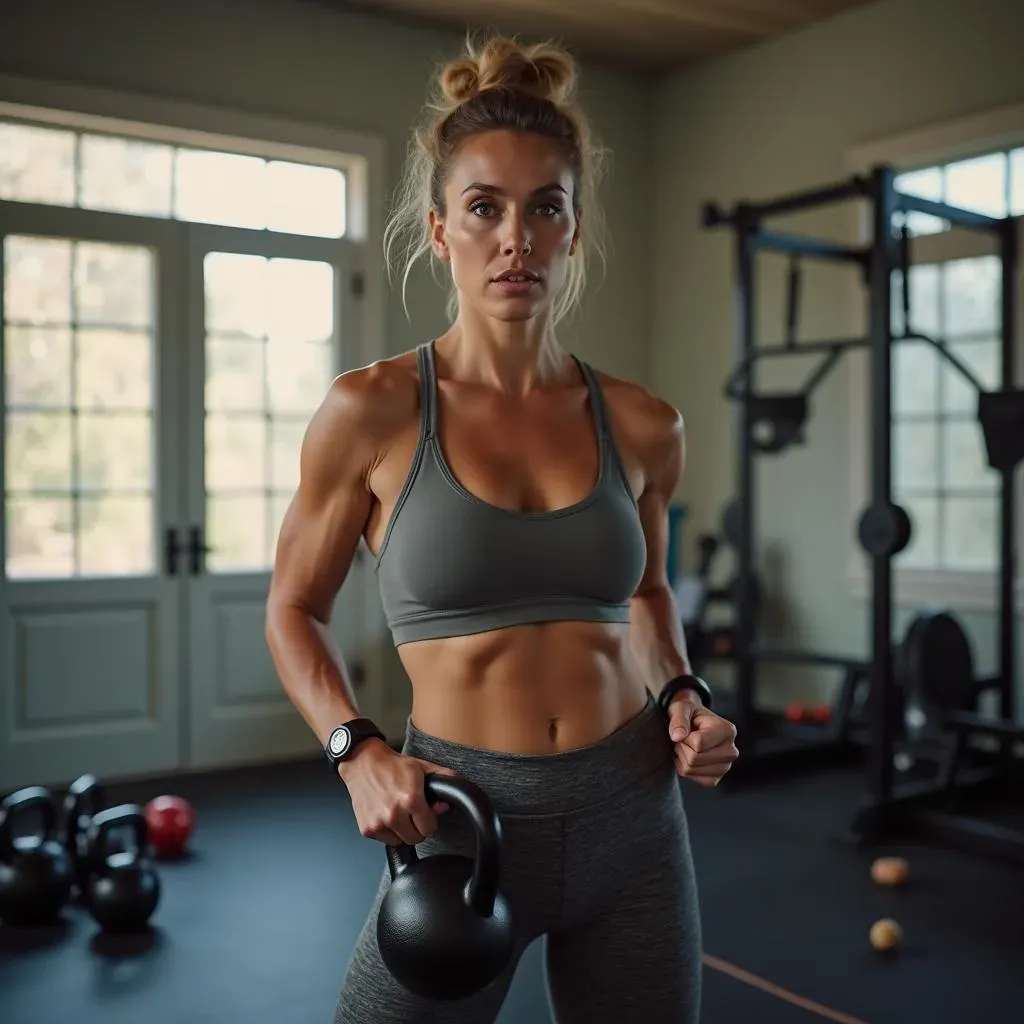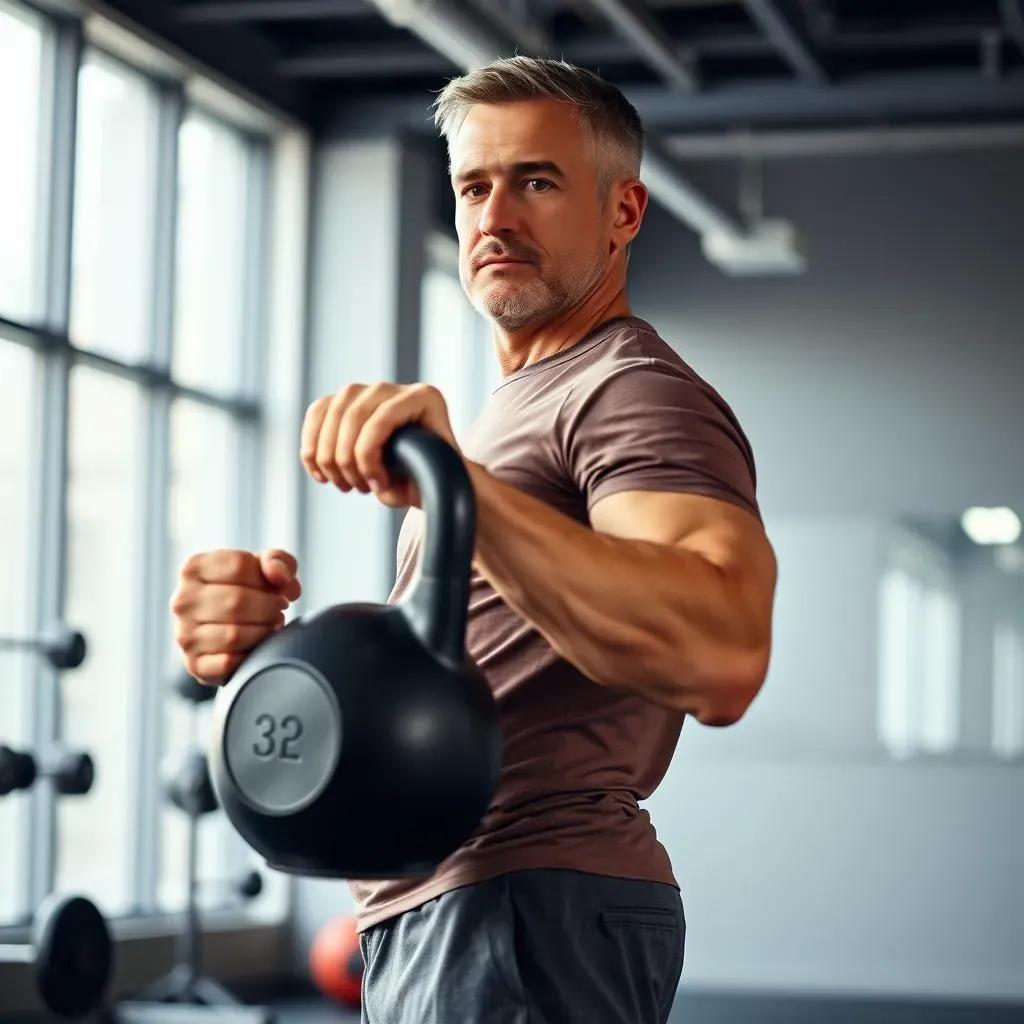Table of Contents
So, you're curious about kettlebells, huh? Maybe you've seen those cannonball-looking weights at the gym and wondered, "are kettlebells good for beginners?" It's a fair question. They look intimidating, but don't let that fool you. Kettlebells can be a fantastic way to get fit, build strength, and even have a bit of fun, but they aren't a magic bullet for everyone. This article will break down the good, the bad, and the wobbly bits of using kettlebells when you're just starting out. We'll cover the main benefits, what to watch out for, common newbie mistakes, and even give you a simple routine to get you swinging safely. Ready to find out if kettlebells are your new best friend or if you should stick to the treadmill? Let's get started.
Kettlebells: A Beginner's Guide to Getting Started

Kettlebells: A Beginner's Guide to Getting Started
What's the Deal With Kettlebells?
Okay, let's get real. Kettlebells aren't some newfangled fitness fad. They've been around for ages, like, way before your fancy gym with all the mirrors. Think of them as a cannonball with a handle – simple, effective, and a little bit badass. Unlike dumbbells, where the weight is evenly distributed, kettlebells have their weight off-center, which makes you work harder to control them. This uneven weight engages more muscles, especially your core. It's like your body is trying to keep its balance while dealing with this unruly weight, and that's where the magic happens.
So, why should you care? Well, if you're looking for a workout that's both strength-building and cardio, kettlebells are your jam. They can help you get stronger, improve your balance and coordination, and even burn some serious calories. Plus, they’re pretty versatile. You can do all sorts of exercises with them, from swings and squats to presses and rows. It's like having a whole gym in one single metal ball. But before you go swinging one around, let's talk about what you need to know as a beginner.
Picking Your First Kettlebell
Alright, so you're ready to join the kettlebell club? Awesome! But hold your horses, you can't just grab the biggest one and go wild. Starting with the right weight is crucial, especially if you're new to this. For most beginners, a good starting point is around 8 to 12 kg (18 to 26 pounds) for women and 12 to 16 kg (26 to 35 pounds) for men. If you’re not sure, it’s always better to start lighter. You can always go up in weight, but starting too heavy is a recipe for bad form and potential injury. Think of it like learning to ride a bike, you wouldn't start on a mountain bike if you've never been on one before, right?
The goal here isn't to show off how much you can lift; it's about learning the movements correctly. Get comfortable with the basic exercises first, and focus on your technique. And remember, form over everything. A lighter weight with good form is way more effective than a heavy weight with sloppy form. Once you feel like you are mastering the movements, then you can slowly increase the weight. So, be patient, be smart, and most importantly, be safe.
Beginner Level | Weight Range (Women) | Weight Range (Men) |
|---|---|---|
Starting Out | 8-12 kg (18-26 lbs) | 12-16 kg (26-35 lbs) |
Comfortable with basics | 12-16 kg (26-35 lbs) | 16-20 kg (35-44 lbs) |
Benefits of Kettlebells for Beginners (and Some Things to Watch Out For)

Benefits of Kettlebells for Beginners (and Some Things to Watch Out For)
The Good Stuff: Why Kettlebells Rock
Alright, let's talk about why kettlebells are actually pretty awesome for beginners. First off, they're amazing for building overall strength. You're not just working one muscle group, you're engaging your whole body, especially your core, which is super important for stability and balance. Think of it like this: every swing, squat, or press is like a mini-workout for all your muscles, which means you get more bang for your buck. Plus, kettlebell workouts are a fantastic way to get your heart rate up, so you're getting both strength and cardio in one go. It's like a two-for-one deal, and who doesn't love that?
Another great thing about kettlebells is that they help improve your coordination and balance. Because the weight is off-center, your body has to work harder to control the movement. This is great for everyday life, like when you're carrying groceries or trying not to trip over your own feet (we've all been there). And let's be honest, kettlebell workouts can be pretty fun. There's something satisfying about swinging that metal ball around, and you feel like a total badass doing it. But before you get too carried away, it's important to know about the potential downsides too. It’s not all sunshine and kettlebell rainbows, you know.
The Not-So-Good Stuff: What to Keep in Mind
Okay, so kettlebells aren't perfect, and it's important to be aware of the potential pitfalls, especially if you're new to this. One of the biggest things to watch out for is improper form. Because the exercises involve a lot of movement, it’s easy to do them wrong, which can lead to injuries. This is why it's so crucial to start slow, learn the basic movements correctly, and maybe even get some guidance from a qualified trainer. Don't just jump in and try to copy what you saw on YouTube, that's a recipe for disaster.
Another thing to consider is that kettlebells can be tough on your joints if you're not careful. If you have any pre-existing conditions or injuries, it's always a good idea to talk to your doctor before starting a kettlebell routine. And remember, listen to your body. If something feels wrong, stop. Pain is your body's way of saying "Hey, maybe we shouldn't be doing that." And if you push through the pain, you will regret it later. It's like trying to run a marathon without training, it's just not going to end well. So, be smart, be careful, and be aware of your limits.
Benefit | Watch Out For |
|---|---|
Full-body strength workout | Risk of injury with improper form |
Improved cardio fitness | Potential strain on joints |
Better coordination and balance | Importance of proper technique |
Fun and versatile workouts | Need to listen to your body |
Are Kettlebells Good for Beginners?: Common Mistakes and How to Avoid Them

Are Kettlebells Good for Beginners?: Common Mistakes and How to Avoid Them
The "Too Much, Too Soon" Trap
Okay, so you've got your kettlebell, you're feeling pumped, and you're ready to transform into a fitness beast. Hold up! One of the biggest mistakes beginners make is going way too hard, way too fast. It's like starting a new video game and immediately jumping into the final boss battle. You're going to get wrecked. Instead of trying to lift the heaviest weight or do the most reps you possibly can, focus on mastering the basic movements first. Start with lighter weights, practice your technique, and gradually increase the intensity as you get stronger. This isn't a race, it's a journey, and you want to make sure you don't burn out or injure yourself along the way.
Another common mistake is ignoring the warm-up. It's so tempting to just dive straight into your workout, but it's like trying to start a car on a cold winter morning without letting the engine warm up first. Your muscles need to be prepared for the workout, so make sure you do some light cardio and dynamic stretching before you start swinging that kettlebell around. And just as important, don't forget to cool down and stretch after your workout. It will help reduce muscle soreness and improve your flexibility. Trust me, your body will thank you later.
Mistake | How to Avoid It |
|---|---|
Lifting too heavy too soon | Start with lighter weights and focus on technique |
Ignoring warm-up | Do light cardio and dynamic stretching before workout |
Skipping cool-down | Stretch and cool down after workout |
The "Form is Optional" Fallacy
Alright, let’s talk about form. It might seem like a boring topic, but it’s actually the most important thing when it comes to kettlebells. Bad form is like driving a car with a flat tire, it may get you there, but it will be a bumpy and dangerous ride. When you’re doing kettlebell exercises, it’s really important to keep your back straight, engage your core, and control the weight. If you’re rounding your back, flailing your arms, or letting the kettlebell swing you around, you’re not only not getting the most out of your workout, but you're also setting yourself up for an injury. It’s better to do fewer reps with perfect form than a ton of reps with bad form.
Another form issue is not knowing how to properly grip the kettlebell. If you are gripping too tightly, you will wear out your forearms quickly, and that will affect other muscles and your workout. You need to grip it just enough to control the weight, and not more. There is a sweet spot you will find over time, but it's better to be aware of it. If you are not sure, there are tons of videos that will explain it. Remember, it’s not about how hard you can grip the kettlebell, it’s about how well you can control the movement and your body. So, take the time to learn the right technique, practice in front of a mirror if you have to, and don’t be afraid to ask a trainer for help. Your body will be forever grateful.
Kettlebell Exercises for Beginners: A Simple Routine to Get You Started

Kettlebell Exercises for Beginners: A Simple Routine to Get You Started
The Foundation: Essential Kettlebell Moves
Okay, so you're ready to actually start swinging this thing? Awesome! Before you go full-on beast mode, let's nail down some basic moves. First up, we've got the kettlebell swing. This isn't just about heaving the weight up and down; it's about hip power and a strong core. Imagine you're doing a tiny jump but instead of going up, your hips are propelling the kettlebell forward. You should feel it in your glutes and hamstrings more than your arms. Then, there's the goblet squat. Hold the kettlebell close to your chest, like you're hugging a baby, and squat down, making sure your knees don't cave in. It's a great way to work your legs and core at the same time. And finally, we have the deadlift. This is all about keeping a straight back and using your legs to lift the weight, not your lower back. These three exercises are the bread and butter of a good kettlebell routine, and they'll give you a solid foundation to build on.
Once you've got those down, let's add a couple of other moves to the mix. The kettlebell press is a great way to work your shoulders and upper body. Start with the kettlebell in the rack position (resting on your forearm, close to your chest) and press it straight up, keeping your core tight. And then, we have the kettlebell row, which is awesome for your back. Bend over slightly, keep your back straight, and pull the kettlebell up towards your chest, squeezing your shoulder blades together. These moves might feel a little awkward at first, but with practice, they'll become second nature. Remember, it’s all about consistency. Just like learning to play a musical instrument, you won't become a pro overnight, but with regular practice, you'll get there.
Exercise | Target Muscles | Focus Points |
|---|---|---|
Kettlebell Swing | Glutes, Hamstrings, Core | Hip power, Straight back |
Goblet Squat | Quads, Glutes, Core | Knees out, Chest up |
Deadlift | Hamstrings, Glutes, Lower back | Straight back, Leg drive |
Kettlebell Press | Shoulders, Triceps, Core | Controlled movement, Core tight |
Kettlebell Row | Back, Biceps | Straight back, Squeeze shoulder blades |
Putting It All Together: A Simple Starter Routine
Okay, now that we've covered the basics, let's put together a simple routine you can try. Remember, this is just a starting point, so feel free to adjust it based on your fitness level and how you're feeling. Start with a 5-10 minute warm-up, doing some light cardio and dynamic stretches like arm circles and leg swings. Then, pick one of the basic exercises (swing, goblet squat, or deadlift) and do 8-10 repetitions with good form. Rest for 30-60 seconds, and then do another set. After that, pick another exercise and do the same thing. Do 2-3 sets of each exercise, and then finish with a 5-10 minute cool-down, stretching all the muscles you worked. It's like a mini-workout buffet, where you get to sample a little bit of everything.
As you get more comfortable, you can start increasing the number of repetitions, the number of sets, or even the weight you're using. But always remember, form is king. It's better to do fewer reps with good form than a ton of reps with bad form. And don't be afraid to take rest days! Your body needs time to recover and rebuild. It’s like a car, you can’t drive it all day long without giving it a break. If you are feeling tired or sore, take a break and come back stronger later. Remember, consistency is key, so try to stick to a regular routine. And most importantly, have fun with it! Kettlebells can be a great way to get fit and feel awesome, so enjoy the process and celebrate your progress.
- Warm-up: 5-10 minutes of light cardio and dynamic stretches
- Workout:
- Choose 2-3 exercises from the list above.
- Do 8-10 repetitions of each exercise.
- Rest for 30-60 seconds between sets.
- Do 2-3 sets of each exercise.
- Cool-down: 5-10 minutes of stretching